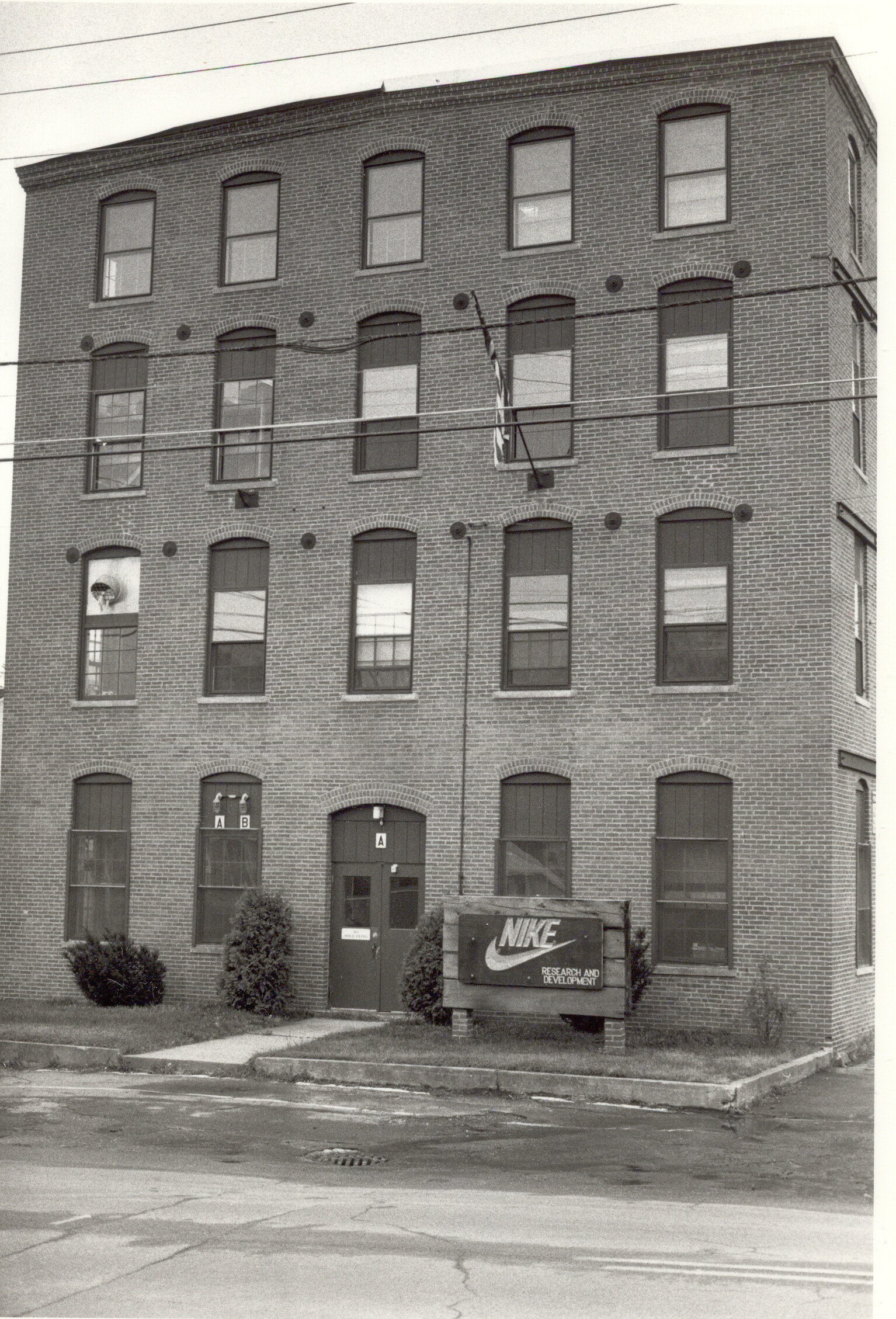By Barbara Rimkunas
This "Historically Speaking" column was published in the Exeter News-Letter on Friday, August 14, 2020.
In 1974, an athletic shoe company called Blue Ribbon Sports began to seriously pursue a location in Exeter. The old Wise Shoe Shop, on Front Street, had been vacant for nearly two years after losing business to foreign imports. Blue Ribbon, itself an importer of Japanese shoes, seemed interested in creating its own product – some of which would be produced in the United States. That firm would rebrand itself as Nike and the plant on Front Street would become its first stateside factory.
Nike’s origin story begins at the University of Oregon, where a recent graduate and student athlete, Phillip Knight, partnered up with his former coach, Bill Bowerman, to import running shoes from the Onitsuka Tiger Company in Japan. The partners had ambitious plans for the future – produce their own athletic shoes scientifically designed for specific athletics. Their first design, the Cortez, was a lightweight shoe with a waffle-type tread. Runners loved the design. After some wrangling with Onitsuka Tiger, in 1971, Blue Ribbon Sports began manufacturing the shoe overseas. They hired salesman Jeff Johnson to help market the shoes. It was Johnson (described as “Employee Number One”) who suggested the name ‘Nike’ – the Greek goddess of victory. Johnson was also tasked with bringing the brand east. There were few runners in the early 1970s outside of high school and college track teams. After looking around for a suitable location, Johnson fixed on the old Wise Shoe shop in Exeter.
The firm’s official name was still Blue Ribbon Sports when it arrived in town. By 1977, the Portsmouth Herald was able to report: “The company’s only manufacturing operations are at Exeter, N.H. which has more than 200 employees, and at Sanford, which employs 40 to 50 persons. The Beaverton (Oregon) headquarters houses the administrative and sales arms of the company.” By that time, the brand had taken off. The iconic ‘swoosh’ logo, designed by Carolyn Davis in 1971 at Portland State University, had become a fashion must. Nike shoes (sneakers as we then called them) appealed not only to elite athletes but also to those who’s most athletic endeavors consisted of walking from the library to the nearby Coke machine. In short order, Nike had 50% of the market. The plant on Front Street produced only a small fraction of the company’s output. Johnson turned it over as the primary location for the firm’s research and development. Johnson explained his interest in the location in a 1979 interview with Exeter News-Letter writer, Alan Greenwood. “First, we knew the New England region is the center of the shoe industry. New Hampshire has plenty of good, experienced shoemakers, and we needed all we could find. And Exeter seemed like the most attractive place for our facility.” Local people were sometimes hired to test new models. Johnson coached the Exeter High School girls’ track team for five years. “Our team wore some shoes before the world had even seen them,” he told Greenwood. “Letting the girls wear some new designs helped give me a chance to see how they liked them.” Greenwood concluded, “Johnson is proud of Blue Ribbon’s accomplishments. ‘We’ve disproved the myth that domestic athletic shoes can’t compete with the foreign manufacturers. We did it by marrying the approach of the athlete and the quality of the shoemaker.” It’s one marriage that shows no signs of breaking up.”
And it did seem that Nike/Blue Ribbon would continue to thrive in New England. With the R&D plant on Front Street and more production happening in Raymond, the company announced, in 1981, that it would be buying the Clemson textile mill on the falls in Exeter. Clemson, part of the huge Milliken Industrials, Inc., had moved into the former Exeter Manufacturing Company in 1966. The plant had closed in 1980 and it looked like the old mill would become a vacant blight as in other New England towns. Nike’s purchase excited the town and provided a renewal of hope in a sagging economy. But even the news announcement had some foreboding. “Johnson said he didn’t think area workers would immediately reap the benefit of new jobs from the company’s expansion, since it will focus primarily on research and design rather than manufacturing.” “’The thrust of this purchase was not to expand our manufacturing capability. There was not the dramatic hit-growth you might expect from one who just acquired a building that size,’ he observed.”
Eighteen months later, the hammer fell. Nike reorganized the structure of the company. Johnson was summoned to Beaverton and offered a reassignment that didn’t involve his research and development in the eastern states. In April of 1983, Nike announced it was closing the doors at the Exeter plant. The 350 workers were told that their jobs would be gone in July. Johnson opted for early retirement. Phillip Knight issued a press release, “that in order to balance production capability with sales and to reduce product costs, Nike will consolidate all domestic footwear production into its Saco-Sanford, Maine facilities.” The R&D facility on Front Street continued for another year.
Both Exeter facilities were later sold. The town’s brief flirtation with the international giant, Nike, had ended after only a few drinks and small talk.
Barbara Rimkunas is curator of the Exeter Historical Society. Support the Exeter Historical Society by becoming a member! Join online.
Photo: The Nike research & development plant on Front Street in the old Wise Shoe Shop. Nike’s first stateside manufacturing plant was located in Exeter from 1974 until 1983.
